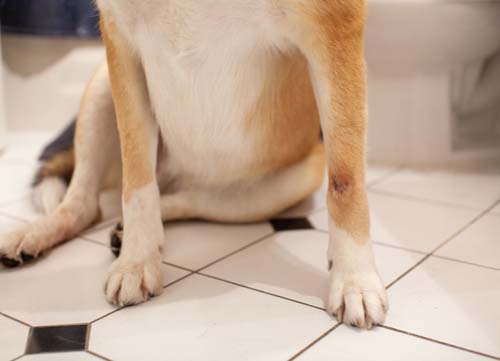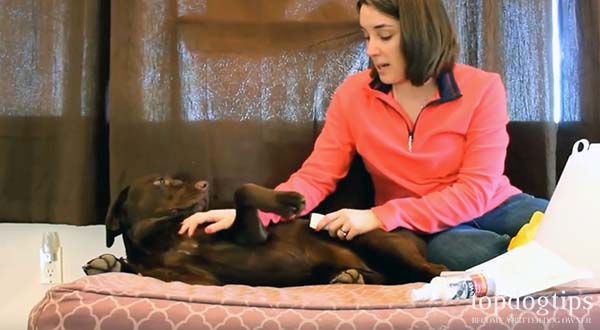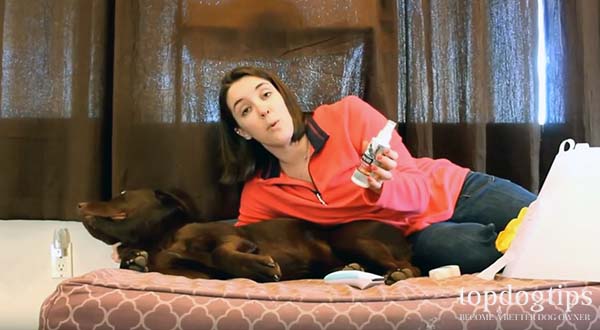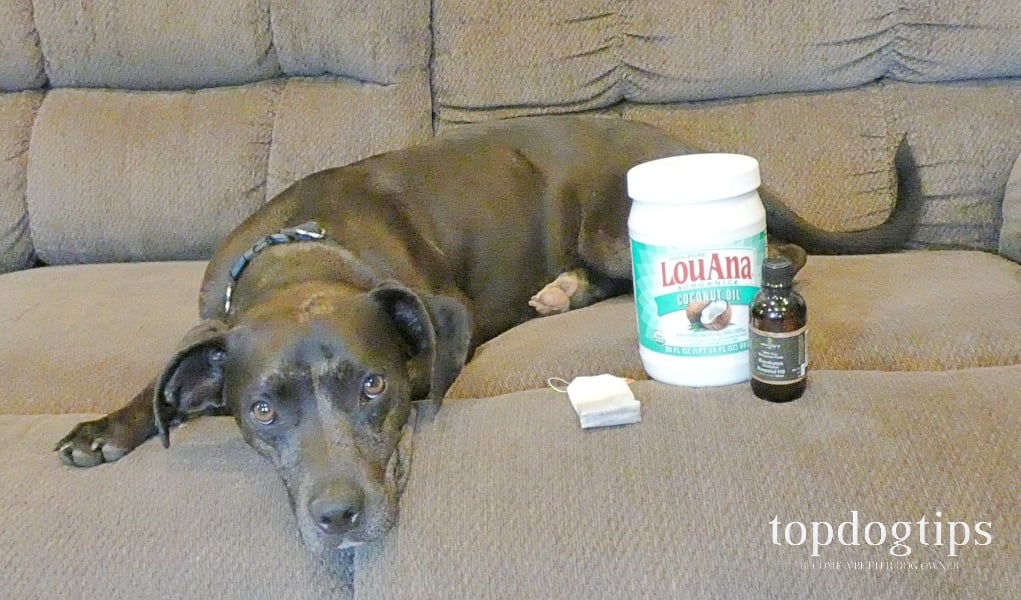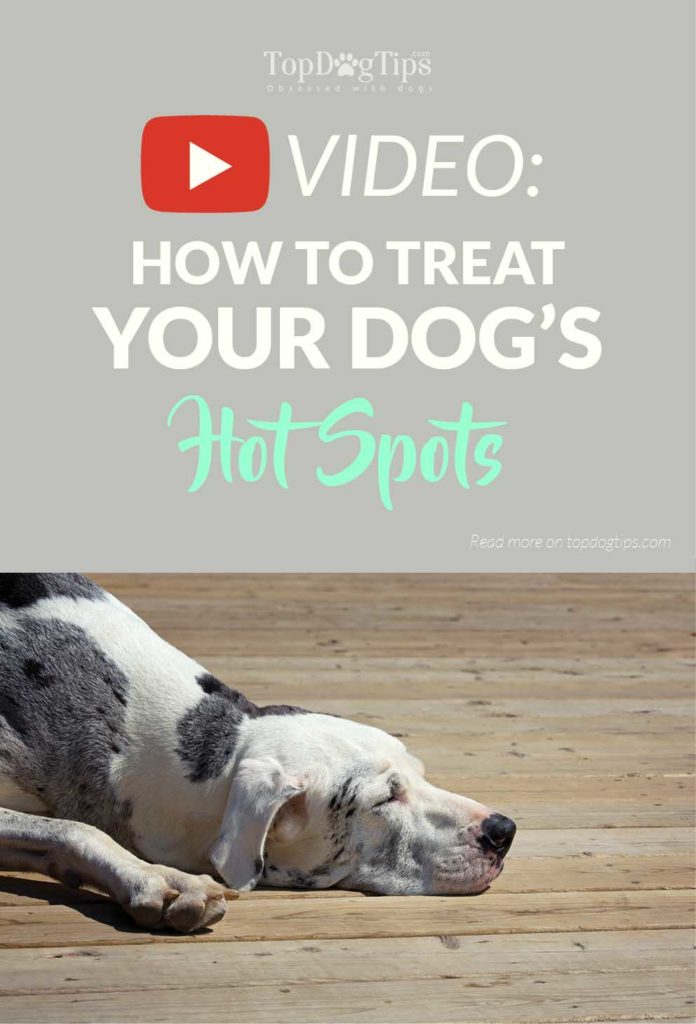Table of Contents
Hot spots on dogs are also referred to as acute moist dermatitis.
They most often appear on a dog's head, chest or hind end.
There are many reasons why these lesions form, and they can be very painful for your pup.
In this article, we will talk about dog hot spots and what the underlying cause is.
We will also go over how to treat hot spots on dogs.
And lastly, we will go over how to prevent future hot spots from recurring.
Hot Spots on Dogs: How Do They Develop?
Anything that irritates a dog's skin will cause him to scratch and chew to relieve the discomfort. While scratching can create lesions on a dog's skin, chewing can be even worse.
The moisture from a dog's saliva that's left behind festers on the skin, and in the dog's fur, and subsequently, that moisture can cause a hot spot on the dog.
The hot spot will become itchy, resulting in even more chewing, and the issue will quickly spread.
It's a vicious cycle.
Proper dog grooming can help to prevent dog hot spots.
Dogs with matted hair and dirty coats are more susceptible to such skin irritations.
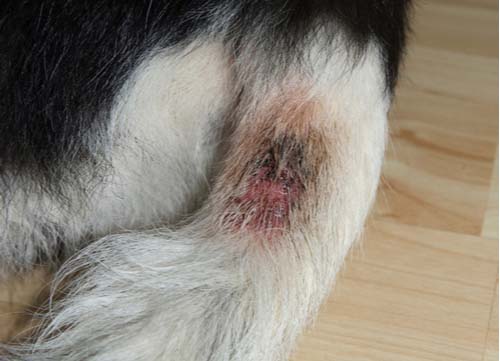
Because hot spots in dogs are caused by moisture, dogs that spend more time outdoors in wet weather or enjoy swimming are more prone to developing hot spots.
So, how do you treat hot spots on dogs?
Pet owners can usually solve this problem at home with both natural and store-bought remedies and without a trip to the vet.
However, if your dog suffers from severe or chronic hot spots on a regular basis, a chat with a veterinarian is recommended.
How to Treat Hot Spots on a Dog
1. Trim the Hair Around the Hot Spot
The first thing you'll need to do is trim the fur around your dog's hot spot using pet hair clippers. I highly recommend using dog clippers instead of scissors or other grooming tools because they'll get closer to the skin without the danger of cutting your dog.
You'll notice that the fur inside the hot spot has fallen out, so you will only need to trim a bit of that hair around the edges.
The goal is to remove all hair that is touching the hot spot. This helps to relieve irritation and will also aid in allowing the skin to dry out faster.
2. Clean the Area
The next step is to clean the area with antiseptic wipes or an antiseptic spray.
This spray will help to kill any germs and prevent further infection on the dog's skin.
Try to find a product that won't sting your pup's skin because this could cause even more irritation and tempt the dog to continue chewing and scratching the area.
Let it dry out, and keep your dog away from licking the area in the meantime.
Note: Before using any antiseptic sprays or creams mentioned below, make sure to consult with a veterinarian and get their approval. In some cases, especially with chronic hot spots, you need to be particularly careful which treatments you're using.
3. Apply a Hot Spot Treatment
Now, you'll need to use a hot spot treatment.
These are usually sold as “hot spot creams” or “anti-itch sprays/creams.”
There are two types: light and natural ones, and stronger remedies used for these and other skin infections in dogs.
Talk to your vet before picking the exact product to see which one is appropriate for your pet's case.
After your vet has approved it, apply the anti-itch spray or cream to the hot spot.
Hydrocortisone-based creams and sprays are the most popular treatment for hot spots in dogs because hydrocortisone was shown in studies to be most effective for this.
My favorite over-the-counter dog hot spot treatments are these three below:
| Preview | Product | Rating | |
|---|---|---|---|

|
Zymox Topical Hot Spot Spray for Dogs and Cats... | 3,139 Reviews | Check Price |
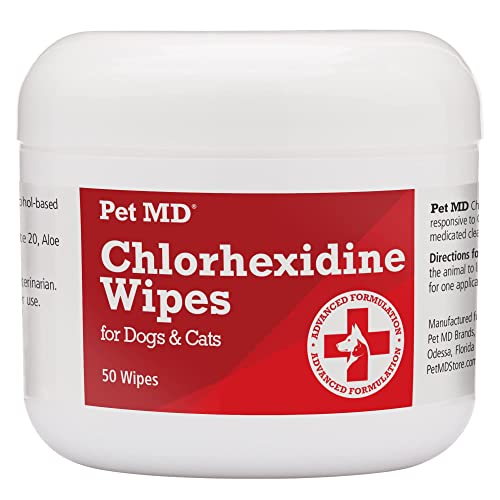
|
Pet MD Topical Wipes for Cleansing - with Aloe for... | Check Price | |

|
BEXLEY LABS Curaseb Medicated Topical Wipes for... | 6,910 Reviews | Check Price |
Note: Make sure that your dog does not ingest any of it. After the cream application, I recommend you use an Elizabethan collar or an inflatable collar for a few days. Personally, I recommend a soft/inflatable collar over Elizabethan collars since dogs like those better.
4. Know When to Talk to a Vet
If your dog has chronic hot spots or they turn severe quickly, you should not treat them at home.
Instead, schedule an appointment with your veterinarian to go over a long-term treatment plan.
Also, if the dog's hot spots have any type of discharge or have a bright red color, they may be infected, in which case you should absolutely avoid treating the area by yourself at home and need to see a veterinarian as soon as possible.
Far more serious skin complications are possible here.
Your vet will likely clean the spots in the clinic and send you home with a prescription skin cream that will clear them up quickly.
These creams are often antibiotic-based and are not available to purchase over-the-counter.
If your dog has chronic hot spots, you may also be prescribed a medicated shampoo that should help with the condition.
5. Natural Hot Spot Remedies for Mild Cases
While you can find over-the-counter dog hot spot sprays and creams to buy online, for very mild cases, you can use natural, chemical-free hot spot remedies like these.
This is what I've successfully used with my dogs in the past for their mild cases.
Calendula oil is the best natural hot spot remedy among the three mentioned that I have found to work on dogs. You can buy this as an oil (like this), lotion, or salve (like this).
It works well to clear up hot spots on dogs quickly without any harmful chemicals or harsh ingredients that might irritate your dog's skin even more.
How to prevent recurring hot spots on dogs
Dogs can develop hot spots for a number of reasons:
- Itching and scratching flea bites
- Dogs with thicker coats or long hair not getting enough baths
- Ear infections that don't get addressed
- Dogs that have anxiety excessively licking themselves
- Food allergies that create skin irritation
- Ultimately caused by the itch-scratch cycle where there is skin inflammation
As you can see, there are many different ways for hot spots to develop.
Preventing hot spots from fleas:
- Make sure your dog is up to date on their flea prevention medication
Other insect bites:
- Keep them from going into thick forests because they are more at risk for tick bites and other insects
- If they won't leave the bite alone and they've created an open wound, treat the area with topical or oral antibiotics with an Elizabethan collar
- This is usually prescribed by a veterinarian
Dogs that aren't bathed or groomed enough:
- Make sure you're giving them a bath at least once a month using a mild soap
- This especially applies to dogs with thick coats because they can develop matted fur
- Matted fur needs to be groomed routinely
- For shorter dog's, you can apply a thin layer of coconut oil
- coconut oil is antibacterial and can help create a healthy skin barrier to skin infections
Ear infections:
- Clean your dog's ears if they've jumped in a pool or ocean that day
- the pool is a breeding ground due to excess moisture
Common Questions on Hot Spots on Dogs
What is the best thing to put on a dog's hot spot?
One of the best ways to treat hotspots is to wipe the sore with an antiseptic solution like chlorhexidine.
You can also use a diluted bath with this or just a shampoo and rub the areas that are affected.
Does Apple Cider Vinegar Help Hot Spots Dogs?
For itchy, dry skin, hot spots, and infections, apple cider vinegar has been known to help treat the wound. You can do this with a bath that has a 1:3 ratio of ACV to water.
Apple cider vinegar is a great home remedy for any skin issues, including fleas and ticks.
Does Coconut Oil Help With Hotspots on Dogs?
Coconut oil has been shown to help with several skin conditions, especially hot spots. Coconut oil has a soothing effect while being an antibacterial salve that you can apply directly to the affected area.
Make sure to let it soak in for 15 minutes before letting the dog go or letting them lick the coconut oil.
Hot Spots on Dogs: Closing Thoughts
Moist dermatitis is something that haunts all dog owners. This is especially true during hot weather; that's why they are called summer sores.
These hot spots, unfortunately, can be very painful.
Fortunately, with appropriate treatment, your dog can bounce back quickly.
If you catch it quickly enough, you can be well on your way to treating hot spots at home.
If you have experience with any of your own home remedies for how to treat hot spots on a dog, please share them in the comments below.
I'm always looking for more natural treatments, and I'd love to try them with our pets, as I'm sure other readers would, too.
READ NEXT: How to Use Coconut Oil for Dog Skin Problems (Based on Studies)
Disclosure: We may earn affiliate commissions at no cost to you from the links on this page. This did not affect our assessment of products. Read more here and find full disclosure here.
Want to share this?


